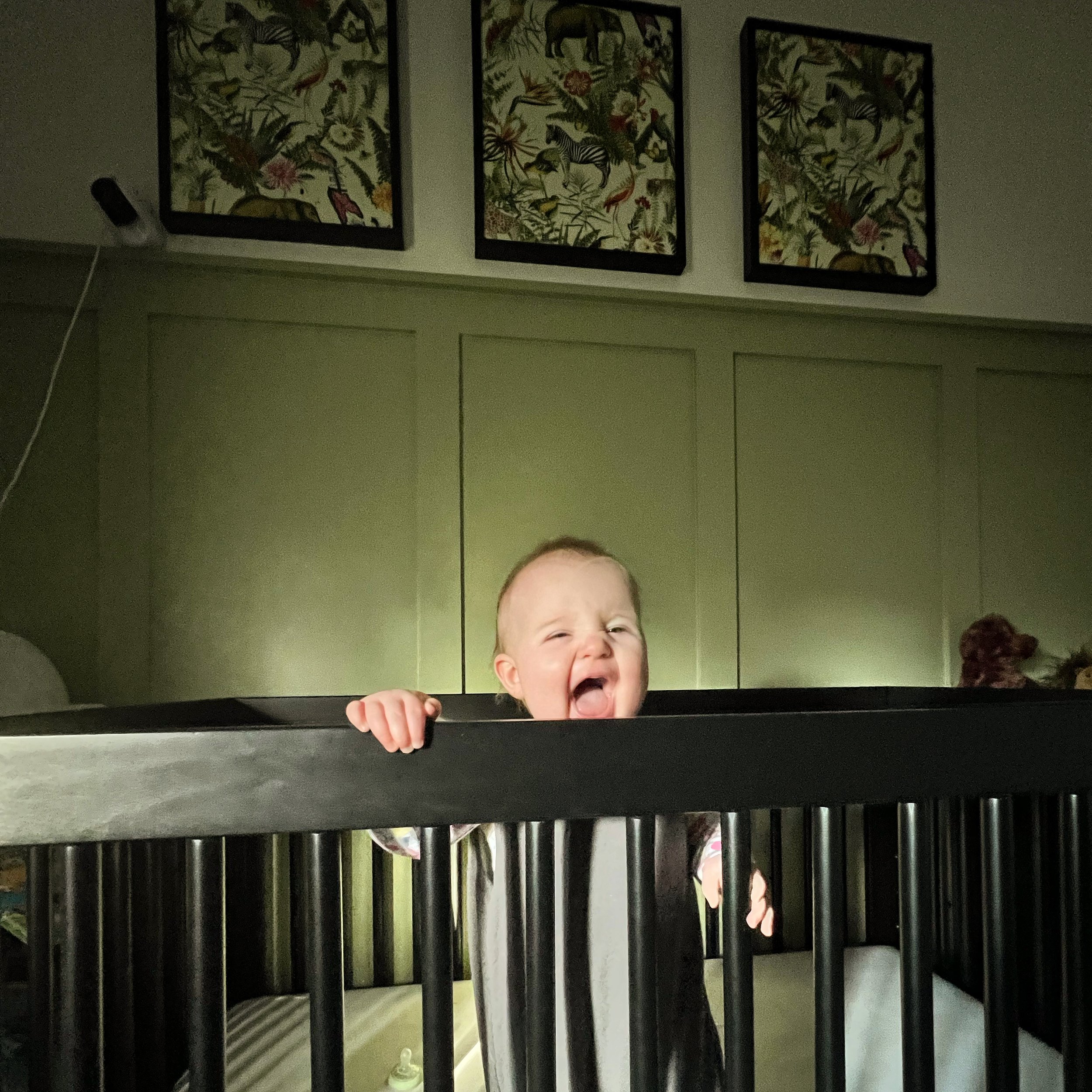Introducing Baby To A Floor Bed
[Hey Mama Rach is supported by its audience. When you purchase through links on our site, we may earn an affiliate commission]
One of the best things I did for myself & my daughter was introduce a floor bed. We went the same route as most parents in the very beginning: bassinet in our room, then an expensive baby crib in the nursery.
At first, it worked here and there. She would co-sleep with us safely in bed or I just wouldn’t sleep if she didn’t want to go in her crib.
Then she stopped wanting to breastfeed to sleep. And she didn’t want to be rocked to sleep. And one night, when she was 8 months old, I woke up to see her climbing out of the crib!!!!
And yes it was on the lowest setting.
Okay, that was it. I was done. There HAD to be another option.
I started researching ‘Montessori Floor Beds’ and came across my answer! After extensive research– I ordered the bed frame, mattress, and other items to make her room safe.
Let’s explore:
- Benefits of a Floor Bed
- Our Floor Bed of Choice
- Safety Proofing Baby’s Room
- Tips for Introducing the Bed to Your Baby/Toddler
The floor bed truly changed my life–find out why below!
Benefits of a Floor Bed
A floor bed is quite simply a bed, on the floor. It could be a mattress placed on the floor (which should be lifted each time baby is awake to prevent molding), or a low frame built around a mattress, or a mattress slightly lifted off the ground.
There are SO MANY options!
Some benefits of a floor bed include:
Promotes independence: the floor bed allows your little one to explore a completely safe space on their own terms. They don’t have to ‘wait for someone’ to get them to move around a little before bed & once they wake up. Toddlers especially CRAVE this. From our experience, the independence then transferred to how my daughter plays throughout the day as well. And she knows, when and if she ever needs us, we will be right there.
Freedom of movement: the larger (unrestricted) space allows your baby or toddler to move and stretch on their own. This helps them develop essential motor skills & practice them whenever they want!
Smooth transition to independent sleep: the floor bed allows the caregiver to comfortably co-sleep or lay next to baby when they need support (which is 100% developmentally normal). Caregivers can nurse baby to sleep and then roll away, leaving baby in a safe space to snooze. Or you can lay next to baby until they are asleep, or if they need some extra cuddles in the middle of the night. Eventually baby will learn how to self-soothe, settle, and fall asleep independently (because you taught them by being there for them!)
Improved sleep quality: with the extra space that a floor bed allows children are free to move around and find a comfortable position that works for them. They aren’t confined to hitting the rails of a crib often, which helps most babies sleep better!
Safe environment: there is little risk of baby injuring themself on the floor bed once the room and space is completely child-proofed. Cribs are associated with more infant injuries than any other nursery product. For some families, starting a floor bed from the beginning can be a great and safe option.
Our Floor Bed of Choice
After allllll the research I did I knew I wanted a larger-sized bed. I wanted it to be lifted off the ground lightly to prevent mold. And I wanted some railing so that I could place it in the corner of the bedroom and not worry about entrapment between the mattress and wall.
I also knew that railing needs to be no larger than 2 ⅜ of an inch apart from each other (which is standard for cribs as well).
The WINNER WINNER is our beautiful full-size floor bed from a small business on Etsy! The quality is amazing and it was very easy to put together.
It gives me comfort knowing that this bed will last a very very long time and, to me, that was worth the price!
For our mattress we chose the Ikea Morgedal Firm mattress. It fit the bed frame well, and had a firm structure we felt really good about.
We use this waterproof mattress cover from amazon & these straps to keep the mattress clean from accidents.
I found this bamboo fitted sheet fit the bed perfectly as it’s thinner than a standard-size mattress. I didn’t want loose bedding as this can be unsafe for babies.
Keep an eye out because I also designed my own bamboo sheets that fit thinner profile beds & hope to launch them soon!
Safety Proofing Baby’s Room
This is probably the most challenging part of the whole process! That’s because most people don’t talk about child-proofing spaces & you want to be diligent!
ANY large, heavy items need to GO: think ottoman, recliner chair, unanchored furniture, tall items that could fall…
Secure furniture to the wall: for example we have a dresser in my daughter's room. It is drilled and secured into the wall so there is no risk of it falling
Cords need to GO: cover them with a protector that secures them to the wall, tie any blinds or cords high up out of reach
Outlets need to be completely covered: having a large outlet protector box works, or using outlet covers works great
All doors need to be safely closed: this means closets (we used these straps), dressers, and even the main door if baby can get out of the room (this is an amazing door locking mechanism we use)
IF YOUR BED FRAME DOES NOT LIFT YOUR MATTRESS OFF THE GROUND, DO SO YOURSELF QUITE REGULARLY. This will prevent mold.
It’s always better to be overly cautious when making a safe space for your baby and their floor bed. Keeping minimal items in their room is a good standard.
We only kept books in my daughter's room & introduced some stuffed animals as she got older.
Introducing the Bed to Your Baby/Toddler
This process will be 100% dependent on what age you introduce the floor bed. Some families decide to start the process from birth. Some transition from bassinet to floor bed. Some transition from co-sleeping to the floor bed. And others may transition from crib/pack-n-play to floor bed a little later on.
As long as you make the space safe, floor beds can be used from any age. An infant who cannot roll will NOT fall out of a floor bed. An infant who can roll, or who might be crawling, can be taught how to safely move down from the bed. A soft rug can also be placed around the bed for a softer landing.
Familiarize your baby with their new space. If they are old enough, show them how to safely move in and out of the bed. Repeat this process often.
Lay down in the bed with them. Depending on how old they are and how they currently sleep, fall asleep or rest your eyes in there with them. This displays the behavior for them & they can start to learn.
It’s okay if your baby wants to move around the room before falling asleep. You have made it safe. As long as they aren’t crying out for you, allow them to explore. Their biological need for sleep will take over and they WILL fall asleep. In the beginning they may need support however, eventually they will do this on their own. Every baby is different 🙂
If they fall asleep on the floor and not their bed simply go in and transfer them. The beginning of their sleep cycle is typically the ‘heaviest’ sleep and can be a good time to do this!
Know that it’s normal to be fearful of a new process. Many of us are only told about crib sleeping, and doing anything different can feel scary! You are not alone. Trust your gut and what feels right in regards to your babies sleep.




